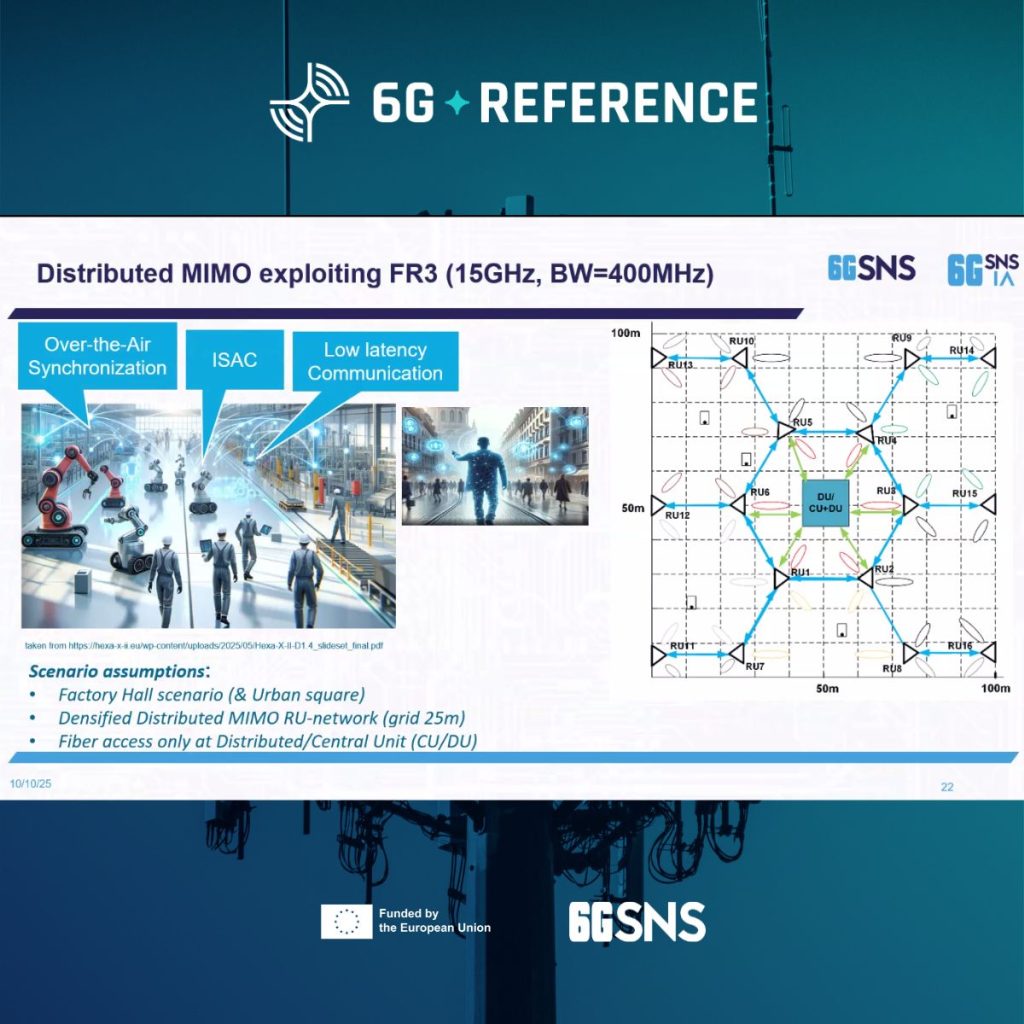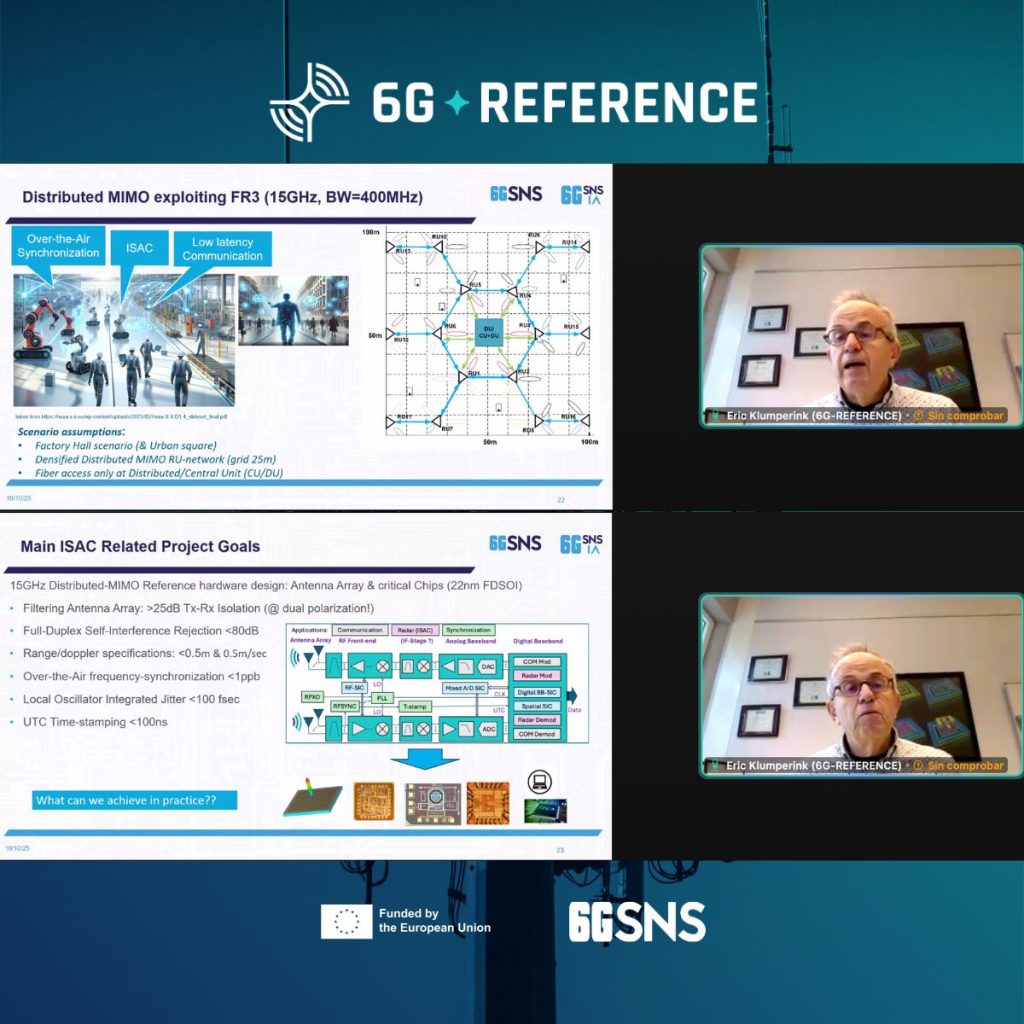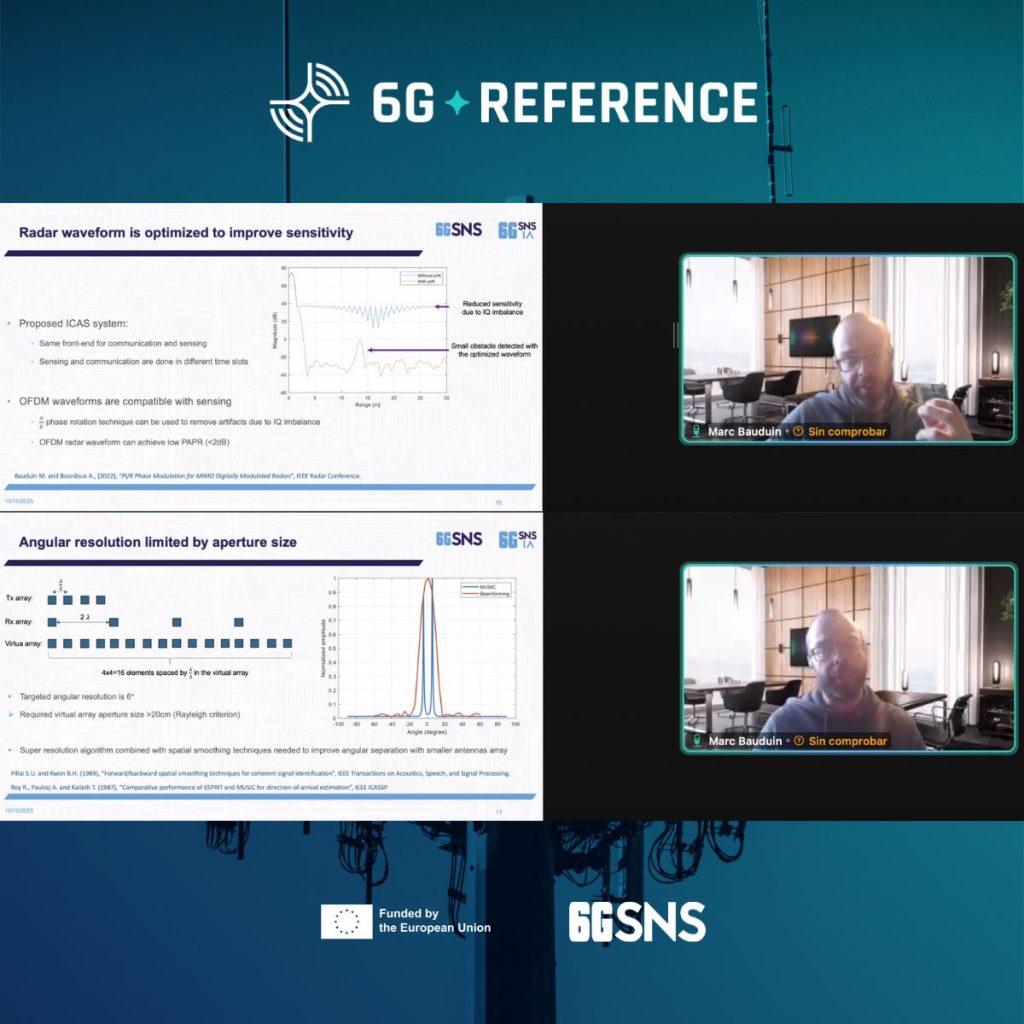On 10 October 2025, 6G-REFERENCE joined over 95 participants in the insightful webinar “6G-IA & 5G-ACIA Highlights, Lessons Learnt and Next Steps on ISAC/JCAS”, co-organised by the 6G Smart Networks and Services Industry Association (6G-IA) and the 5G Alliance for Connected Industries and Automation (5G-ACIA), with the support of the SNS CO-OP project. The event was a significant milestone in the ongoing dialogue around Integrated Sensing and Communication (ISAC) and Joint Communication and Sensing (JCAS), technologies expected to define the next generation of mobile networks.
After Didier Bourse, the Core Team Chairman of the 6G-IA SNS Work Programmes Task Force (Nokia), presented the webinar and the agenda, the session opened with warm welcomes from Raffaele de Peppe, Vice-Chairman of the 6G-IA Board, and Afif Osseiran, General Chair of 5G-ACIA. They offered complementary perspectives from both the Smart Networks and Services Joint Undertaking (SNS JU) programme and the industrial automation domain, setting the stage for three focused sessions on use-cases, research, and standardisation.
Session 1: ISAC/JCAS Use Cases and Requirements
The first session explored real-world use cases and technical requirements.
Didier Bourse introduced the SNS JU project landscape, followed by presentations from several SNS projects including:
- Eric Klumperink (6G-REFERENCE)
- Sebastian Robitzsch (Multi-X)
- Konstantinos Maliatsos (iSEE-6G)
- Giyyarpuram Madhusudan (6G-DISAC)
- Izzat Darwazeh (6G-MUSICAL)
Our Technical Manager, Eric Klumperink, Associate Professor at the University of Twente, introduced the 6G-REFERENCE ISAC scenarios, focusing on a factory hall with fiber access only at Central/Distributed Unit (CU/DU).
From the industrial side, Hanwen Cao (5G-ACIA WG1, Huawei) contributed the perspective of connected industries and automation, highlighting specific industrial sensing scenarios and their communication needs.
The session concluded with a brief Q&A, reflecting strong interest in aligning research goals with industry requirements.
Session 2: ISAC/JCAS Research & Innovation, Validation and Challenges
The second session focused on cutting-edge innovation and ongoing validation efforts.
Kostas Trichias, Chairman of the 6G-IA SNS Technology Board, led the segment for SNS JU. Once again, several projects presented their approaches, including:
- Marc Bauduin (6G-REFERENCE)
- Hui Chen (6G-DISAC)
- Sebastian Robitzsch (Multi-X)
- Konstantinos Maliatsos (iSEE-6G)
- Izzat Darwazeh (6G-MUSICAL)
Marc Bauduin, Research Engineer at Imec, spoke about the 6G-REFERENCE OFDM radar waveform with improved angular resolution, in which the radar waveform is optimized to improve sensitivity.
From 5G-ACIA, Atte Länsisalmi, Chair of WG3 on System Architecture and Integration (Nokia), spoke about the role of sensing in assisting positioning systems, and shared insights from WG3 white papers.
Key challenges discussed included hardware reuse, signal synchronisation, and waveform design, topics central to the 6G-REFERENCE research agenda.
Session 3: ISAC/JCAS Standardisation and Impact
This session addressed the critical topic of standardisation and the broader impact of ISAC/JCAS on the 6G ecosystem.
Alex Kaloxylos, Executive Director of 6G-IA, led the session from the SNS JU side. Project contributions included:
- Stefan Andersson (6G-REFERENCE)
- Kyriakos Stylianopoulos (6G-DISAC)
- Sebastian Robitzsch (Multi-X)
- Izzat Darwazeh (6G-MUSICAL)
Stefan Andersson, Manager Radio Frequency Frontend at Ericsson, shared our project’s vision on the future of ISAC/JCAS standardisation and its potential for impact generation.
On the 5G-ACIA side, Michael Bahr (WG1 Chair) highlighted ongoing standardisation work in industrial automation and its interplay with ISAC capabilities.
Closing Remarks and Looking Ahead
In the concluding segment, Raffaele de Peppe emphasised the strategic importance of ISAC as a differentiator for 6G, particularly in terms of safety in manufacturing environments and new monetisation avenues for the network.
Afif Osseiran reiterated the strong synergies between research initiatives and industry, and Didier Bourse announced a follow-up webinar on ISAC/JCAS planned for Spring 2026, underlining the momentum and growing community around this topic.
The 6G-REFERENCE Perspective
From the 6G-REFERENCE viewpoint, the event was an invaluable platform to exchange knowledge and reinforce alignment with both academic and industrial stakeholders. Eric Klumperink shared his impressions:
“It was interesting to see a broad variety of ISAC use scenarios in industrial environments, which is a key focus area of the Alliance for Connected Industries and Automation (ACIA). Many of the ISAC requirements from different industrial use scenarios align well with what we are aiming at in 6G-REFERENCE: low-cost, low-complexity integrated circuit hardware for full-duplex communication; accurate over-the-air synchronisation in frequency, phase and time; and efficient hardware solutions that reuse communication hardware for ISAC via smart waveform design.” – Eric Klumperink, 6G-REFERENCE Technical Manager and Associate Professor at the University of Twente.
The team was particularly encouraged to see how research objectives within 6G-REFERENCE map closely onto concrete industrial demands, validating the project’s approach and boosting its relevance for future 6G deployments.
The webinar was recorded and will soon be made available via the Smart Networks and Services Joint Undertaking (SNS JU) website.








